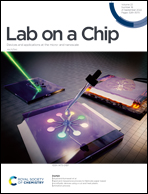Acoustofluidics 24: theory and experimental measurements of acoustic interaction force†
Abstract
The motion of small objects in acoustophoresis depends on the acoustic radiation force and torque. These are nonlinear phenomena originating from wave scattering, and consist of primary and secondary components. The primary radiation force is the force acting on an object due to the incident field, in the absence of other objects. The secondary component, known as acoustic interaction force, accounts for the interaction among objects, and contributes to the clustering patterns of objects, as commonly observed in experiments. In this tutorial, the theory of acoustic interaction forces is presented using the force potential and partial-wave expansion approaches, and the distinguishing features of these forces such as rotational coupling and non-reciprocity are described. Theoretical results are compared to experimental measurements of interaction forces using a glass micro-capillary setup to explain the practical challenges. Finally, the phenomenon of clustering patterns induced by the close-range interaction of objects is demonstrated to point out the considerations about multiple collision and the predicted clustering patterns entirely due to the interaction force. Understanding the principles of acoustic interaction enables us to develop novel acoustofluidic applications beyond the typical processing of large populations of particles and with focus on the controlled manipulation of small clusters.



 Please wait while we load your content...
Please wait while we load your content...